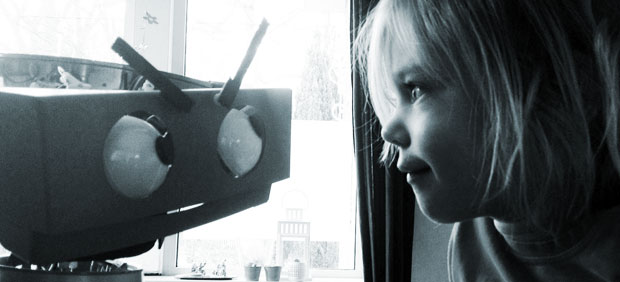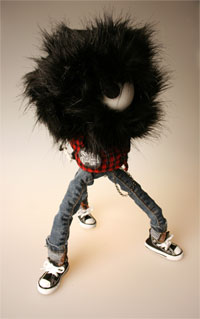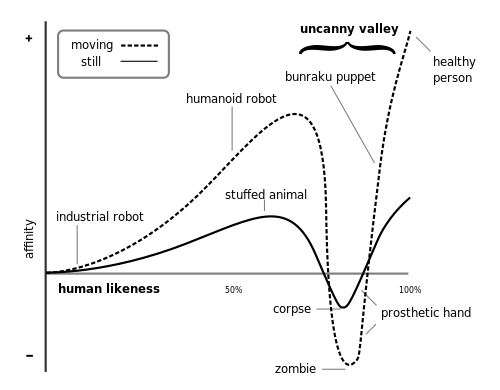

I grew up in the 70’s and 80’s, watching a lot of low budget sci fi shows on TV. By lack of comparison, I thought it was very cool that a super awesome space adventure could unfold on a bridge of a massive spaceship, with the main characters just talking to eachother. All you needed to become a space explorer was a lot of imagination and a uniform. So that’s what I mainly did with my friends, when we were 6 years old. We talked about the “space anomalies” and “unknown forms of energy” just outside the window of the classroom, and the strategies we needed to save the school from total destruction from these unknown forces. In my mind I was escaping the gravity of this planet and was going where no 6 year old boy had gone before.
After a while I began to notice the patterns in the Star Trek - Buck Rogers - Battle Star Galactica scripts. Nowadays, when I watch those old shows, I find those patterns very comforting, but back then it meant that my early sci fi addiction was craving for something more challenging. That’s how I found the more serious writers like Philip K. Dick and Isaac Asimov. You can imagine after all those “bidi-bidi-bidi”’s these new stories completely blew my mind. In fact, similar to the big bang, they are still blowing my mind, and even more now than back then.
Many people were reading Asimov’s Foundation series, but I my favorites were the shorter Robot-stories. That led of course to the 3 Laws of Robotics and the emotional struggles a Robot can have with those laws. The other sci fi master, Philip K Dick, wrote a book called “Do Androids Dream of Electric Sheep”. That book was made into the cult classic “Blade Runner”. I watched that movie as soon as it came on video, probably long before it was appropriate for my age, and for the second time before the age of 12, my mind was blown away by a vision of the future, that felt hauntingly real to me. I have picked up many pop culture influences when growing up, but most of them didn’t make such a big impact like Blade Runner and Asimov’s Robots.
I was destined to go to the university and study physics but that is when exact science and my imagination became completely disconnected from each other . I had to drop out and that was the end of my space exploration career. A few years later this internet-thing started and I began making my first websites and audiovisual productions. In the mid-90’s I had started a small webproduction studio in Antwerp. Around the turn of the century, small was not a guarantee for success. So a few years later I started working at BBDO in Brussels. There I started making flash games, a lot of flash games. I became an Art Director and began making advertising concepts. In 2009 I left BBDO to continue working for different agencies with my one-man production studio: Slightly Overdone.
When I was making games I could do the designs, development and the concepts of the games. I liked making very physical games with a lot of mechanics simulations in them. I also discovered my interest in Character Design with the games. That’s how I first started going to the Pictoplasma conference in Berlin. I have been going to the conference every year since the beginning. The conference gathers Character Design enthusiasts from around the world and we have a lot of fun watching and making Characters for a couple of days. When I came back from the conference in april 2012, on Monday the 16th at 9 am more precisely, I got a phonecall from Niels Schreyers from the agency Boondoggle. His question was very simple yet it held all the potential to change make career forever. His question was: “Can you build us a Robot?”
My name had come up, because I have made several interactive installations at BBDO that had gotten some attention in the industry. For example the Dodge Viper Bungee and the Mini Burn Unit.
My head was still filled with characters from the Pictoplasma conference so even though I had no idea what I was getting myself into, the only possible answer to his question was: “Sure!”
Five weeks after that phone call Yummy needed to be on stage for a video shoot. The agency had created a campaign for Delhaize, a large supermarket chain in Belgium. Kids could collect trading cards, with food and ingredients in them, in the stores. They could then go to the campaign website and give these ingredients to Yummy the Kitchen Robot. Yummy would then present a recipe from somewhere in the world with these ingredients. So Yummy needed to appeal to children, he lived in a kitchen and he could perform simple movements with his arms and face. During the five weeks of development every flat surface in our house was taken over by robot parts. You can watch a timelapse here. I lived and breathed robots and I made the deadline with not a lot to spare. On the last night of the development phase, something not entirely unexpected happened. For the first time with his face complete, Yummy looked right at me, and a kind of emotional link was made between us...
Although sometimes very stressful, the development of Yummy was also very rewarding and a lot of fun. So I decided this was what I wanted to do with my studio: making physical stuff and Robots in particular. I decided at that moment I was going to be a roboticist. I started thinking about how Yummy related to the other Robots in the world. Robots usually have a purpose. They are perfect and very functional in nature. Yummy had none of these qualities. In fact he was very bad at a lot of things. When I showed him to other people I soon discovered he had other qualities, like imperfection, beauty, maybe even a form of empathy. He can be very engaging. Those are very important qualities to a character designer, but I could not find a lot of other examples in other Robots around the world. I started making more Robots, with very simplistic concepts. They were build in very tight constraints and that caused people to their operation as a kind of struggle. Their imperfections became a reflection of the imperfections of people looking at them. I got these kinds of feedback from showing my projects online and talking to people. It was very surprising to get these kinds of feedback, and also very encouraging... Nermahl is a drawing Robot and Bradley is linked to a Kinect controller. He is convulsively trying to mimic your posture when you stand in front of him, to that degree that you almost feel sorry for him.
Since my Robots don’t talk (yet) I had to rely on body language to communicate with the audience. I read about Desmond Morris and I always thought the idea of involuntary communication through body language very intriguing. That how I got the idea for the Kinesics project. The first project, the Pinecap, is a woolen cap with 9 pins on top. The pins rise or drop depending on the attitude of the person wearing the cap. With a softer approach the Magnolia-project does the same with an artificial flower.
 The first idea of building Herb was very practical in nature. Yummy was way too big to take with me when I was giving lectures and workshops, so I wanted another character that weighed less. I had learned from other character designers that it is very normal for characters to start talking back to you, once you have constructed a enough of their background stories. So with Herb it was clear he was going to be a kind of hipster-woodsman crossover with three legs.
The first idea of building Herb was very practical in nature. Yummy was way too big to take with me when I was giving lectures and workshops, so I wanted another character that weighed less. I had learned from other character designers that it is very normal for characters to start talking back to you, once you have constructed a enough of their background stories. So with Herb it was clear he was going to be a kind of hipster-woodsman crossover with three legs.
“Sooner or later Robots are going to kill us all,
but before they do, first they will steal our jobs.”
Since I started making Robots I also started giving a lot of lectures at conferences and in schools and agencies. Everywhere I went sooner or later somebody would make a joke about humanity being destroyed by Robots. It’s like this idea is a profound part of our culture. When reading online about Robots and society the idea of losing jobs to Robots is also very popular.It is obvious that the most advances Robots today are being build by military funded organisations. If you combine this with hundreds of popular sci fi stories, like The Terminator, The Matrix, Battlestar Galactica, Blade Runner and so on, where Robots do want to kill all (or most) of humanity, it’s not hard to see where this fear comes from.
Another important element is the quest of many roboticists to create the perfect artificial human. I had to pleasure to meet Hiroshi Ishiguro last summer in Linz, Austria. Without doubt he is a real robotics hero to me. The concepts behind his projects and the technical achievements he has accomplished are mindblowing. However, with my experiences in character design I am having some difficulties to instantly like some of his creations. The reason for this is the infamous “Uncanny Valley”.

The hypothesis states that as the appearance of a robot is made more human, a human observer's emotional response to the robot will become increasingly positive and empathic, until a point is reached beyond which the response quickly becomes that of strong revulsion. However, as the robot's appearance continues to become less distinguishable from that of a human being, the emotional response becomes positive once again and approaches human-to-human empathy levels. (source wikipedia)
Many humanoid robotics projects get stuck deep in the Uncanny Valley, because it is really hard to do, despite the amazing technical challenges they are overcoming. Millions of Euro’s and Dollars are being spent on crossing that valley, and without doubt, sooner or later that valley will be crossed successfully, and roboticists will reach the bank of the perfect human copy. If you take a look at the graph you will notice there is also another bank on this valley. The left side is where the not-so-human Robots live. They can have all the technical capabilities like their cousins on the right side, but they don’t look human. They may have fur, or look like a kitchen utensil… I believe very strongly that this side is where a lot of very cool Robots can be created in the very near future. I hugely admire the work of Carla Diana. She is clearly on a similar track and I am really curious about her future projects.
During my brief conversation with Dr. Ishiguro he also told me about the question of a Robot Soul that was still on the table. I regret that I could not go into that topic more deeply during our brief encounter, because a Robot Soul was exactly what I had noticed that last night before Yummy’s deadline, when I had pieced the final parts of his face together. If a pile of nuts and bolts can make an emotional connection with an observer, than what else could that be but the first glimpse of an Robot soul...
If we think for a moment about a human soul. Among many different interpretations, by my opinion, it is something that links all humans together. Remember when Felix Baumgartner was jumping down from the edge of space ? Millions of people were watching his experience live because we all realized Felix is also a human being like us. His jump made all of humanity a little cooler that day. The same happened with the 7 brave men that walked the surface of the Moon. Many of us don’t know what they were doing there exactly, but what really mattered was that they were human beings, just like us, with arms and legs and a head, just like you and me. We were all on the Moon those days with them. (Even if many of us weren't even born yet.)
Now if we take a look at what Nasa did with the Mars rover Curiosity. It was inconceivably difficult to get that Robot down there, but now he is there, doing his job, in very harsh conditions, day and night. He is a true Robot hero. So isn’t it a little sad he doesn’t look more like a space exploration hero ? Curiosity looks very ready for the job at hand. There is no doubt about his purpose there, but where is his emotional appeal ? How can I make an emotional link to this machine ? There must have been people at Nasa who thought about the emotional link, because they gave him, for instance, a Twitter account, so you can talk to him. He never answers me by the way. I am probably asking the wrong questions. Imagine for a moment what it would be like if the Robots on Mars would look a lot more like character we can relate to. Can you imagine then how many people would follow the missions every day ? “But why would humans want to emotionally relate to a machine ?” To answer that I will look at the numerous stories and movies where people do want to make this emotional connection, like Wall-E, Roy Batty in Blade Runner and many others. I can witness this everyday with the Robots I created, when I see how my kids interact with them.
If we go back to the previous popular statements about Robots I would like to alter them like this:
To conclude I would like to acknowledge that I am taking a lot of inspiration from very fantastic resources like movies and sci fi stories. In a way I am still the 6 year old boy that is trying to escape this planet to go on an adventure, but before you think this is all the rambling of a grown man with a pending mid-life crisis, I want to reassure you that this is not some extreme form of escapism in my mind. To the contrary, it is the exact opposite. It is very normal for 6 year old boys and girls to make up fantastic dreams and adventures. Those dreams then escape into the vastness of space and time, often never to return to them in their adult life. That is a huge loss I believe. Can you image the enormous potential of the dreams that are already out there ?
Jan De Coster
Contact Jan De Coster